- The Luminary Network
- Posts
- Perspective on being Employee #8 at a YC-backed AI Company
Perspective on being Employee #8 at a YC-backed AI Company
Finding your passions in college, and building an outbound sales motion
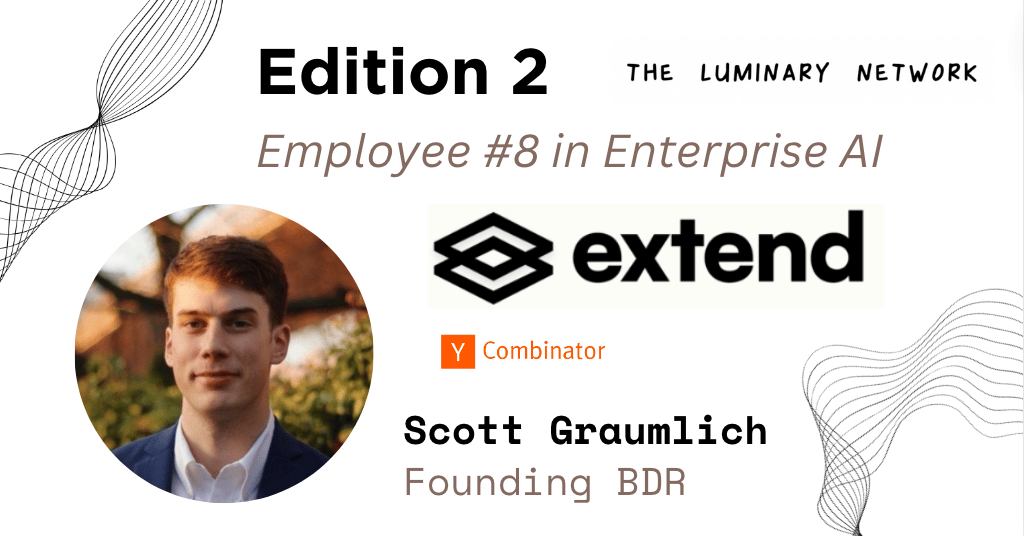
The issue of manually extracting unstructured data is painful, to say the least. In today’s issue, I share a gold mine of insights from my discussion with founding Business Development Representative at Extend, Scott Graumlich.
Here’s what’s included for today👇
Today’s schedule:
Overview: Y Combinator-backed startup, Extend 🟠
Key Insights from Scott 💡
tips for finding your passions while in school
perspective from an ultra-early stage operator
Unstructured Data Solutions Market Overview 📊
Refer a Friend 🧑🤝🧑
Say Hi 👋
Not subscribed to The Luminary Network? Sign up below to gain direct perspective from the boldest founders, operators, and investors in tech & innovation!
Extend: Automating your Business Operations with AI
In an age where businesses of all sizes and across all industries are migrating to the cloud, data kept in unstructured formats (e.g. PDFs, images, and email text) is even more valuable - and the traditional method of manual human parsing - a painfully inefficient process - is an ineffective use of a business’s finite resources. Often, many companies staff employees exclusively to manually extract data from documents, and place that data into a structured format (in a tabular spreadsheet, or JSON file).
Previous solutions relied on optical character recognition (OCR), a technology within pattern recognition that was birthed in the early 1920s, which parses pre-determined data out of a rigid, established document format. As many documents that businesses work with differ substantially in their structure, this unfortunately, only covers a minute fraction of reality.
Extend is leveraging the explosion of LLMs like Llama and Chat GPT to layer traditional OCR technology on top of these publicly available models, to intelligently and seamlessly extract data from documents that have starkly different formats.
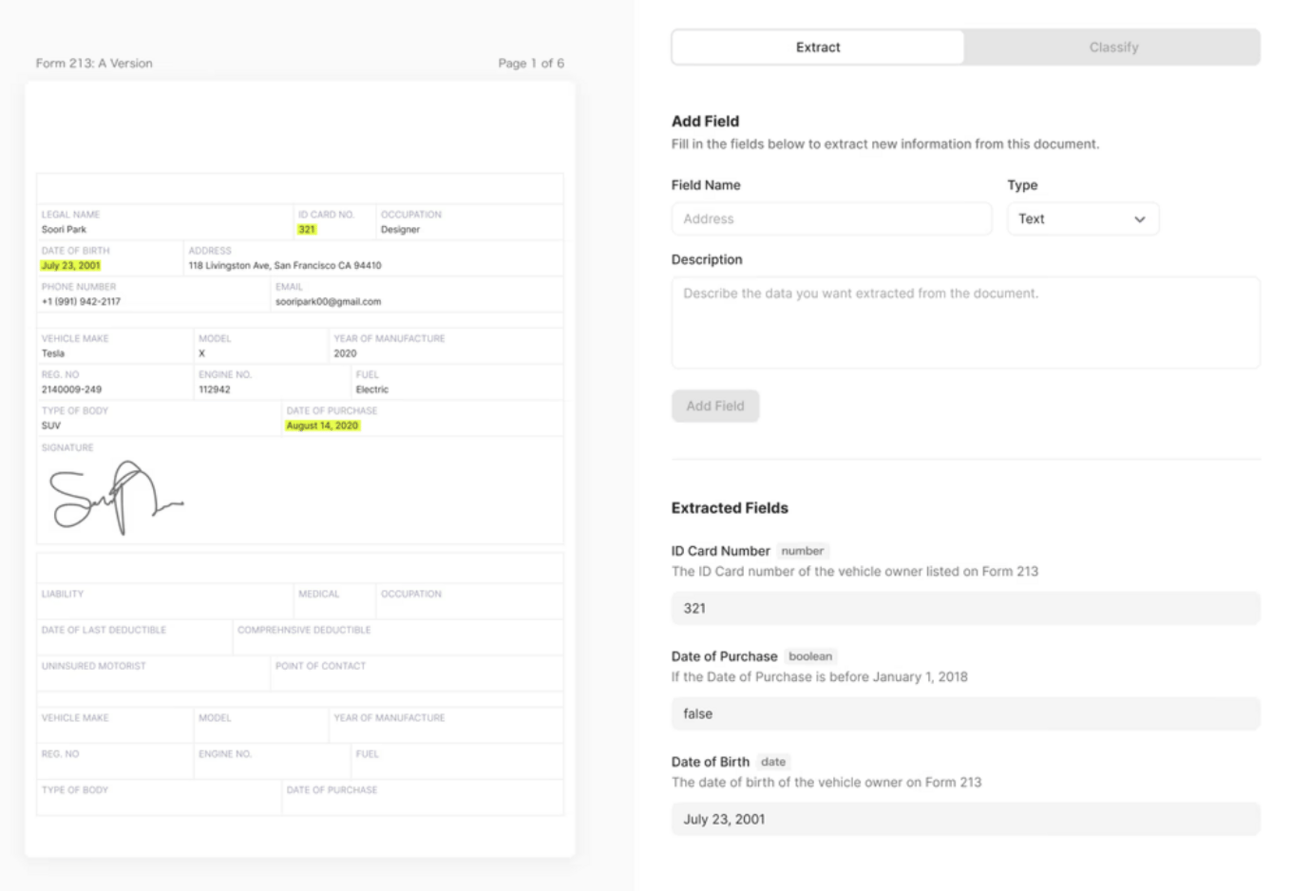
Extend’s User Interface
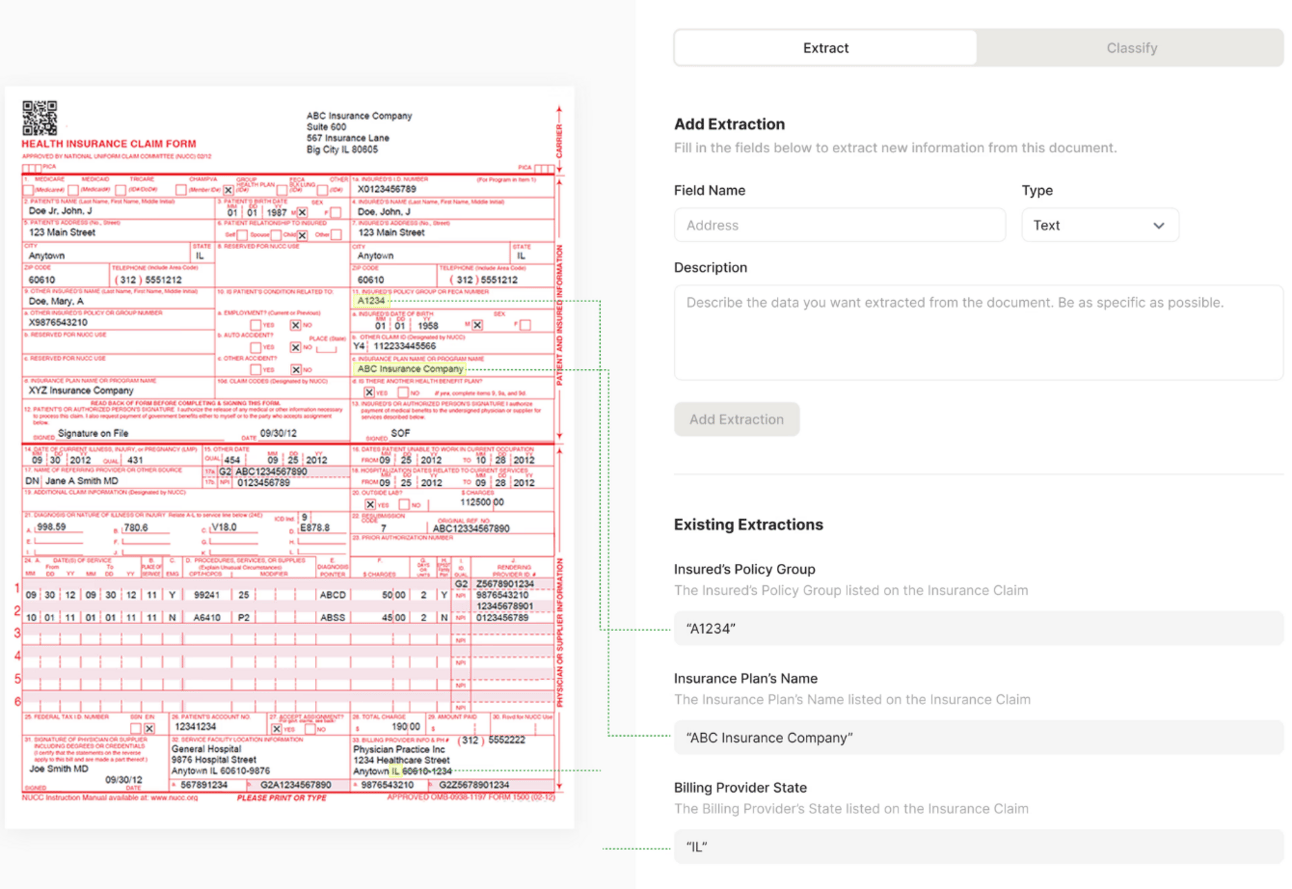
Extend’s User Interface
Now, customers can seamlessly automate their data extraction processes, with a simple user interface that pulls any field from any document, and places them in a semi-structured JSON file (simple to convert into a structured CSV format).
This solution enables businesses to cut budget on hours that employees spend manually extracting data, and enables those individuals to spend these hours doing revenue-generating work. This is a fascinating solution in the broader data automation software market, which we’ll dive into later in this issue.
Internal and External Usability
Extend can be used internally for back office tasks (e.g. a grocery store can extract data from consumer receipts or vendor invoice data). It can also be used by Extend’s customers to power the core functionalities of their product, which enables the customer’s end-users to seamlessly extract data from documents they upload, in real time (Y Combinator).
Document Classification
If a customer repeatedly uses documents with the same format (same fields in the same location), document classifications can be created, which enable the product to extract data with even stronger accuracy.
For example, if a company wants to extract data from its owned invoices, it can create an extractor that specifies the fields to be extracted, the data type for each field, and a brief description of the content within each field. By creating document classifications, the model can reference its prior performance on the same document type, and learn from its mistakes.
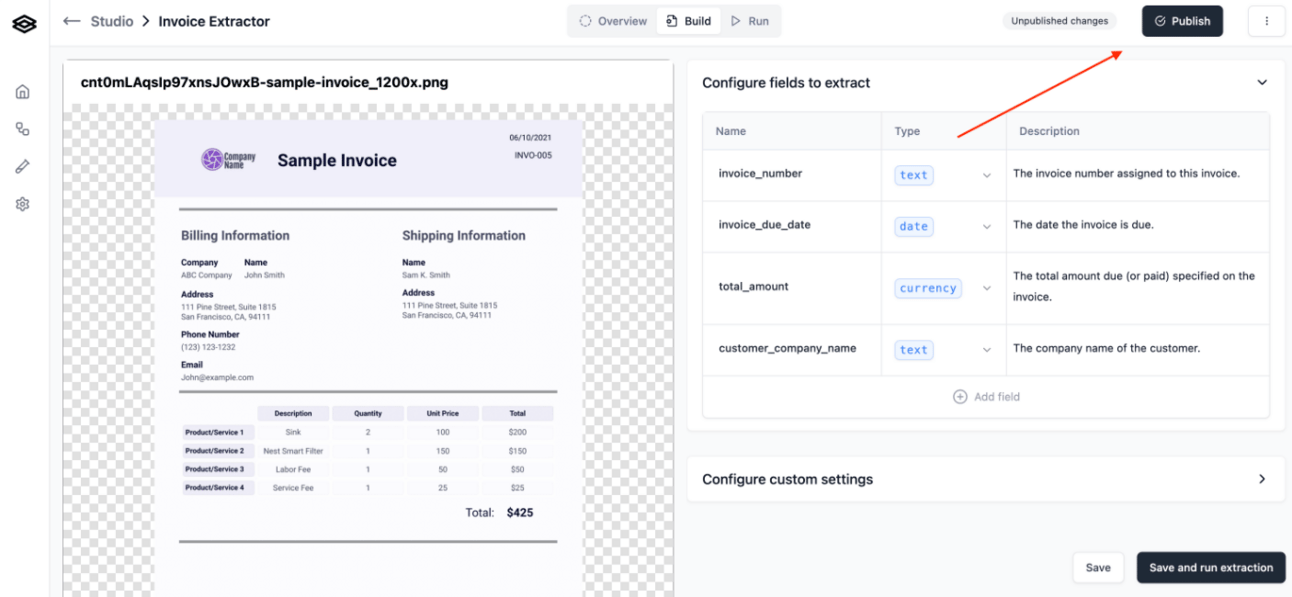
Source: Extend
Confidence Scores
An awesome feature that I liked when Scott demoed the product with me, was the confidence score feature. For example, let’s say that a document with a rather unfamiliar layout is provided by a user. For each field that Extend extracts, it provides a numeric value that reflects how confident the system is that this value is correct (see below). In the few instances that a human review is needed, the user’s attention is directed to the exact area where they need to take a second look. This feature, combined with source of truth data, enables the model to improve its accuracy over time.
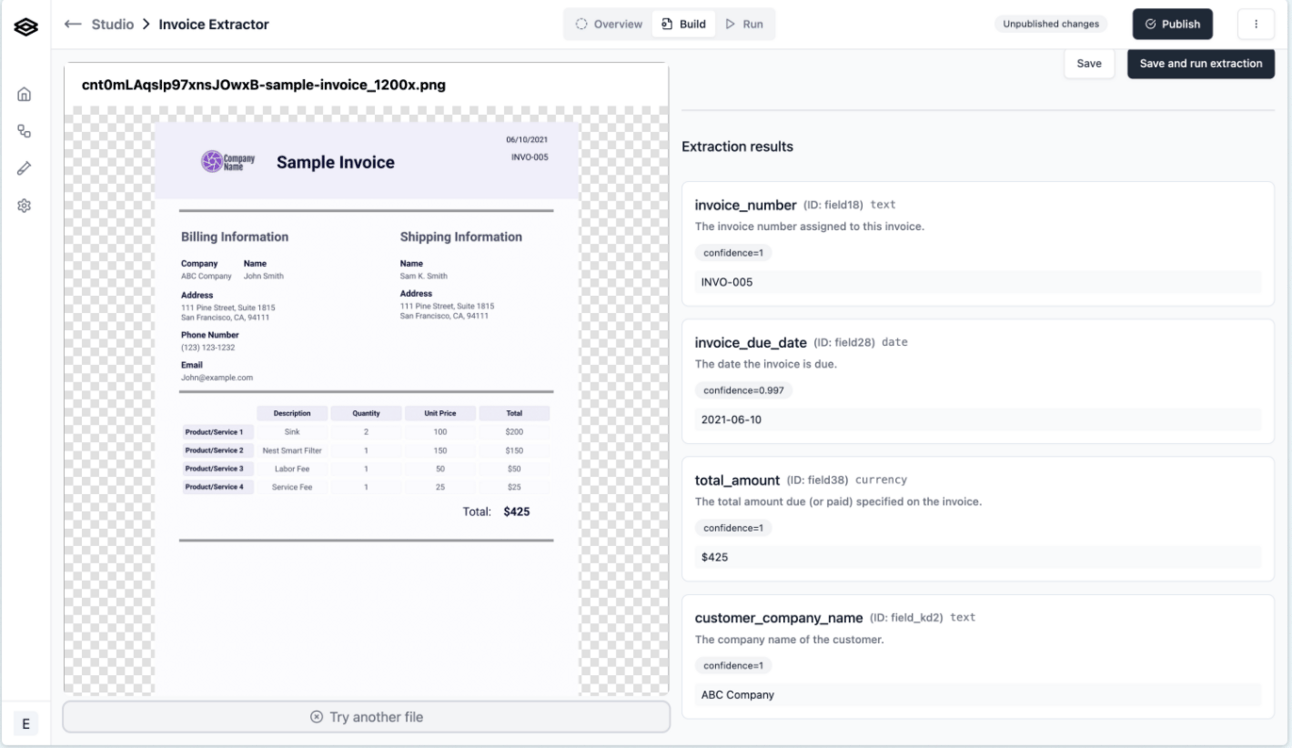
Source: Extend
Insights from my discussion with Scott
First, a bit about Scott:
Founding Business Development Representative at Extend, based in New York City 🗽
Currently building out go-to-market motion
Passionate about contributing to hyper-growth at a company’s earliest stages
Aspiring VC, after completing two internships at Refinery Ventures and Zell Capital (now Vessel)
Insight #1: Your time in college is the chance to try anything, and explore what energizes you.
Scott and I met through our business fraternity in college, so we both have perspective on this. Scott initially thought he’d go into engineering, and serendipitously landed into business after applying to a single business program. He chose Business Economics for its versatility, and didn’t find his groove until he became an entrepreneurship co-major.
As a 19 - 20 year-old sophomore, he took the helm of the $500,000 Miami University Social Impact Fund, which invests $25,000 checks in pre-seed to seed stage companies with a social impact ethos. From his time leading the fund, he learned how to manage conversations with founders, and lead diligence research on investment targets.
Scott further leaned into his curiosity for innovation and venture, by doing summer internships with two early-stage VC firms (Zell Capital (now Vessel) and Refinery Ventures). He knew that venture was his long-term objective, and as he got closer to graduation, and talked to dozens of people in the innovation space about how to break in.
“99 out of 100 people said you’ve got to get into an operator role at an early stage startup”
The overwhelming consensus, was that to provide the most value to a fund in the future, it would be best to experience hyper growth at an early-stage company. Naturally, he believed the clearest path into this type of role, was in sales. He saw a LinkedIn posting at a Series A outbound cloud contact center company called Regal.io, and introduced himself to the entire management team. “You have to sell yourself. You have to show them that you’re willing to be scrappy. That’s what it takes at a startup.”

Regal.io logo
Scott emphasized how much he learned about selling strategies and talking directly to customers’ pain points while at Regal, but knew he wanted to have a more profound impact on a company’s development from its very earliest stages of development (pre product-market fit).
Through a coworker at Regal, he was introduced to Ian Feeney at The Cannon Project - a talent agency that matches high performers with sales roles at early stage technology companies. Feeney sourced the opportunity at YC-backed Extend, and Scott joined as the founding business development representative → Employee #8.
Insight #2: In an early stage startup, the autonomy you’re given is second to none. You’re the proverbial ‘wearer of many hats’.
“I’m in a 10×10 sq ft. coworking space with the most genius people I could imagine.”
What I found energizing from my conversation with Scott, was his description of the work environment. 4 of the 8 team members are in San Francisco, and 3 others are with Scott in New York. “The sales director is an arm’s length to my right. If I turn around, the CEO and the founding engineer are right behind me. This is what you get at an early-stage company.”
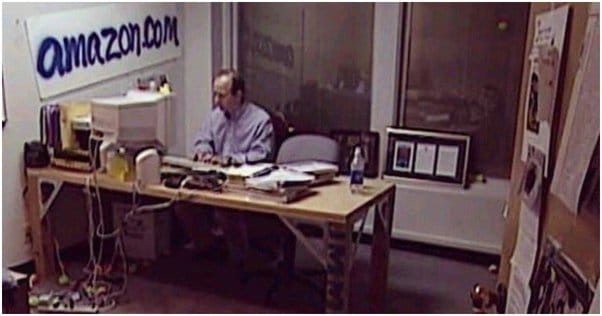
Jeff Bezos building Amazon in the 1990s
As the only BDR at a company that is still working on nailing product-market fit, Scott is responsible for establishing the ideal customer profiles (ICPs) of consumer segments that would be of interest to Extend, while owning outreach to each of these segments.
Insight #3: Don’t sell technology, sell the solution to your customer’s problem.
Customers don’t care about the features of the product, they only care about whether their problem can be resolved
Scott emphasized that you HAVE to be a product expert in his role. However, more importantly, you need to understand how your product resolves the unique challenges your customers face. “I have to study the markets and industries of the consumer segments I’m targeting, to truly understand the problems they’re experiencing. It’s so critical to have the right industry knowledge and language to even earn yourself the right to sit at the table. The messaging I use when I’m on the phone with a Director of Engineering starkly contrasts to what I use with a Director of Operations.”
A key tip that he has found to be especially useful, is not to sell technology, but to instead speak to the customer’s problem, and that you have a solution that can solve their problem.
Essentially, Scott is tasked with figuring out what groups of customers would gravitate the most toward Extend’s solution, crafting messaging that appeals specifically to their problems, and equipping himself with segment-specific knowledge. While this is absolutely the type of impact he wanted, he emphasized that his time in a more structured, established environment at Regal was crucial in preparing him for this role.
Deep-Dive: Unstructured Data Extraction Solution Market
With the advancement of technologies such as the internet and mobile devices, the variety of data has shifted. Before the ‘Information Age’, the majority of data was structured data, meaning it is tabular (think spreadsheet-format).
Because the internet has given rise to applications like Instagram, Facebook, Yelp, and other data collection creations like internet of things, the prevalence of unstructured data has skyrocketed. Unstructured data, lacking a tabular format, includes documents (like tax documents, receipts, etc.), videos, and digital, web-based text (e.g. social media captions).
In fact, ~80% of all data generated today is unstructured. These new ingestion channels have also caused the volume of data to skyrocket, as well. When you pair this with the finding that only 18% of organizations use their unstructured data (Deloitte, 2019), there’s evidently an issue.
Essentially, organizations are generating more data than ever, yet they’re commonly unable to use a large portion of it due to the lack of an efficient solution to bring structure to unstructured data. This prevents this unused data from being ingested into the data pipeline, and subsequently prevents its use in a variety of data products, such as AI models, data visualizations, or in application programming interfaces (APIs).
Extend’s solution focuses on automating the extraction of unstructured data from PDFs, images, emails, and more, which enables companies to more quickly and effectively use the data for these different use cases.
Emergence of Data Lakehouses for Seamless Data ingestion and analytics
Founded in 2013 and 2012, respectively, Databricks and Snowflake have scaled to become the two foremost data engineering platforms. Specifically, each of these platforms enable customers to bring their data into a data lakehouse, a data architecture which combines the data warehouse (comprised of structured, tabular data) and the data lake (comprised of unstructured data). The data lakehouse enables customers to combine all of their organization’s unstructured, semi-structured, and structured data into a single location.
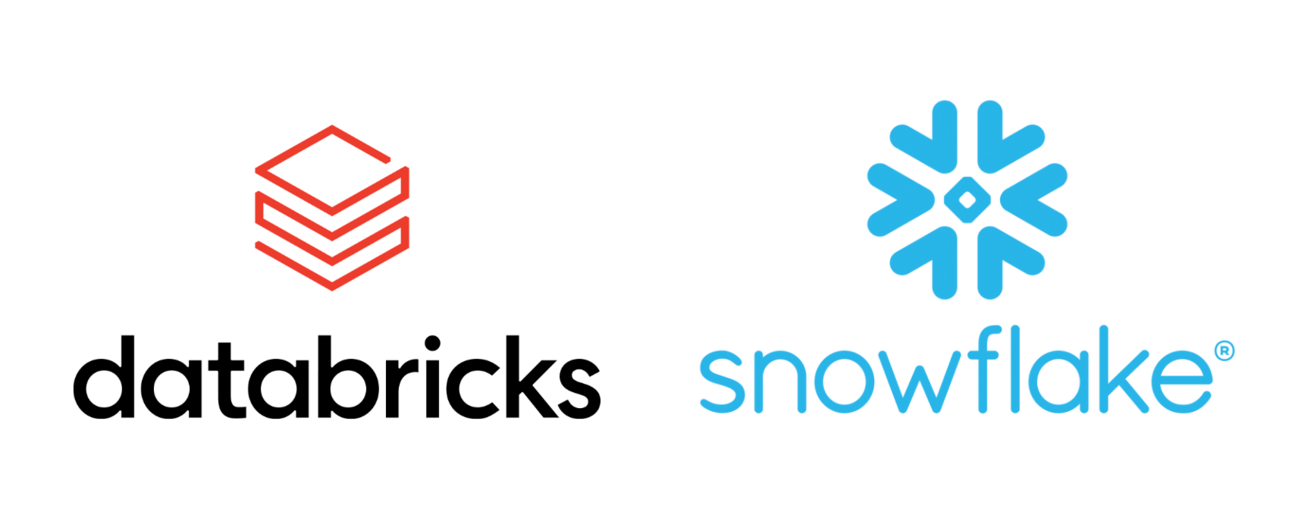
The two leading data ingestion, computation, & analytics market leaders
Once all data is ingested in the data lakehouse, it can easily be used for AI and business intelligence applications. The reason I reference this, is to highlight that no only was it previously a major inconvenience for companies to extract their unstructured data, but it has also never been easier to derive value from all data, using Databricks and/or Snowflake’s offerings.
With the entrance of Extend, customers can now turn the ~80% of their data that was previously unusable, and seamlessly derive insights from it using platforms like Databricks and Snowflake. It’ll be excited to see the growth of Extend’s business in the coming years!
Refer a Friend 🤝🏻
Click the button below to refer a friend if you liked today’s content!
Connect 👋
A major THANK YOU to Scott for sharing his perspective on working in VC and what it’s like to be an early operator. Connect with him on LinkedIn!
Also, feel free to connect with me on LinkedIn, or via email at [email protected]. I appreciate any and all feedback!
Lots of exciting plans in the works. 🚀
-Jack